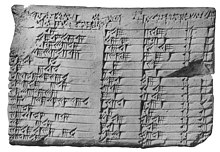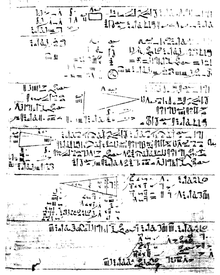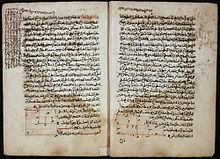History of algebra
The word "algebra" is derived from the Arabic word الجبر al-jabr, and this comes from the treatise written in the year 830 by the medieval Persian mathematician, Al-Khwārizmī, whose Arabic title, Kitāb al-muḫtaṣar fī ḥisāb al-ğabr wa-l-muqābala, can be translated as The Compendious Book on Calculation by Completion and Balancing.
According to one history, "[i]t is not certain just what the terms al-jabr and muqabalah mean, but the usual interpretation is similar to that implied in the previous translation.
[13] The solutions were possibly, but not likely, arrived at by using the "method of false position", or regula falsi, where first a specific value is substituted into the left hand side of the equation, then the required arithmetic calculations are done, thirdly the result is compared to the right hand side of the equation, and finally the correct answer is found through the use of proportions.
Book II of the Elements contains fourteen propositions, which in Euclid's time were extremely significant for doing geometric algebra.
[25] Data is a work written by Euclid for use at the schools of Alexandria and it was meant to be used as a companion volume to the first six books of the Elements.
[29] Chiu-chang suan-shu or The Nine Chapters on the Mathematical Art, written around 250 BC, is one of the most influential of all Chinese math books and it is composed of some 246 problems.
[32] Ssy-yüan yü-chien《四元玉鑒》, or Precious Mirror of the Four Elements, was written by Chu Shih-chieh in 1303 and it marks the peak in the development of Chinese algebra.
The four elements, called heaven, earth, man and matter, represented the four unknown quantities in his algebraic equations.
[36] Algebra was practiced and diffused orally by practitioners, with Diophantus picking up techniques to solve problems in arithmetic.
[37] In modern algebra a polynomial is a linear combination of variable x that is built of exponentiation, scalar multiplication, addition, and subtraction.
[47] The recurring themes in Indian mathematics are, among others, determinate and indeterminate linear and quadratic equations, simple mensuration, and Pythagorean triples.
[52] He is the author of Lilavati and Vija-Ganita, which contain problems dealing with determinate and indeterminate linear and quadratic equations, and Pythagorean triples[48] and he fails to distinguish between exact and approximate statements.
The Muslim[58] Persian mathematician Muhammad ibn Mūsā al-Khwārizmī, described as the father[59][60][61] or founder[62][63] of algebra, was a faculty member of the "House of Wisdom" (Bait al-Hikma) in Baghdad, which was established by Al-Mamun.
It no longer concerns a series of problems to be resolved, but an exposition which starts with primitive terms in which the combinations must give all possible prototypes for equations, which henceforward explicitly constitute the true object of study.
[73] The similarity between these two works has led some historians to conclude that Arabic algebra may have been well developed by the time of al-Khwarizmi and 'Abd al-Hamid.
[77] Al-Karaji (953–1029), also known as Al-Karkhi, was the successor of Abū al-Wafā' al-Būzjānī (940–998) and he discovered the first numerical solution to equations of the form
The historian of mathematics F. Woepcke, in Extrait du Fakhri, traité d'Algèbre par Abou Bekr Mohammed Ben Alhacan Alkarkhi (Paris, 1853), praised Al-Karaji for being "the first who introduced the theory of algebraic calculus".
[77] Al-Hassār, a mathematician from Morocco specializing in Islamic inheritance jurisprudence during the 12th century, developed the modern symbolic mathematical notation for fractions, where the numerator and denominator are separated by a horizontal bar.
Scholars fled the West towards the more hospitable East, particularly towards Persia, where they found haven under King Chosroes and established what might be termed an "Athenian Academy in Exile".
At the end of 16th century, François Viète introduced symbols, now called variables, for representing indeterminate or unknown numbers.
The idea of a determinant was developed by Japanese mathematician Kowa Seki in the 17th century, followed by Gottfried Leibniz ten years later, for the purpose of solving systems of simultaneous linear equations using matrices.
The theory originated in 1884 with the German orientalist Paul de Lagarde, shortly after he published his edition of a 1505 Spanish/Arabic bilingual glossary[99] in which Spanish cosa ("thing") was paired with its Arabic equivalent, شىء (shayʔ), transcribed as xei.
) Evidently Lagarde was aware that Arab mathematicians, in the "rhetorical" stage of algebra's development, often used that word to represent the unknown quantity.
[101] Lagarde was unaware that early Spanish mathematicians used, not a transcription of the Arabic word, but rather its translation in their own language, "cosa".
[103][104] Although the mathematical notion of function was implicit in trigonometric and logarithmic tables, which existed in his day, Gottfried Leibniz was the first, in 1692 and 1694, to employ it explicitly, to denote any of several geometric concepts derived from a curve, such as abscissa, ordinate, tangent, chord, and the perpendicular.
As explained by Andrew Warwick, Cambridge University students in the early 19th century practiced "mixed mathematics",[106] doing exercises based on physical variables such as space, time, and weight.
For instance, the issue of constructible numbers showed some mathematical limitations, and the field of Galois theory was developed.
The title of "the father of algebra" is frequently credited to the Persian mathematician Al-Khwarizmi,[107][108][109] supported by historians of mathematics, such as Carl Benjamin Boyer,[107] Solomon Gandz and Bartel Leendert van der Waerden.
[65] Other supporters of Al-Khwarizmi point to his algebra no longer being concerned "with a series of problems to be resolved, but an exposition which starts with primitive terms in which the combinations must give all possible prototypes for equations, which henceforward explicitly constitute the true object of study."
[116][117] Pre-modern algebra was developed and used by merchants and surveyors as part of what Jens Høyrup called "subscientific" tradition.















